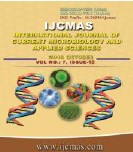


 National Academy of Agricultural Sciences (NAAS)
National Academy of Agricultural Sciences (NAAS)

|
PRINT ISSN : 2319-7692
Online ISSN : 2319-7706 Issues : 12 per year Publisher : Excellent Publishers Email : editorijcmas@gmail.com / submit@ijcmas.com Editor-in-chief: Dr.M.Prakash Index Copernicus ICV 2018: 95.39 NAAS RATING 2020: 5.38 |
A study was undertaken at West Bengal, India with hybrid sunflower cv. Aditya, during winter season of 2011-12 and 2012-13 in a split-plot design with three levels of irrigation (main-plots) and seven levels of sulphur (sub-plots) with three replications. Among the phenotypic traits evaluated, significant (p ≤ 0.01) and positive correlation were detected between WFSC and SI (r = 0.44), SEY (r = 0.58) and STY (r = 0.41); between SI and SEY (r = 0.49) and STY (r = 0.41); between SEY and STY (r = 0.59, p ≤ 0.01). Seed yield showed highest significant (p ≤ 0.01) positive correlation with TNU (r = 0.670), TBU (r = 0.669) as well as with AN (r = 0.602). The OC had significant (p ≤ 0.01) positive correlations with LA (r = 0.874), OA (r = 0.909) and IV (r = 0.936), while significant negative correlations was observed with PA (r = -0.905), SA (r = -0.828) and SV (r = -0.929). Among the growth and yield components, BG (0.612) followed by NFSC (0.579) and WFSC (0.577) exhibited highly positive direct effects on seed yield of hybrid sunflower. The standard regression equation showed that independent variables like total N uptake, plant height, available N, weight of filled seeds/capitulum and seed index (100-seed weight) had positive significant relationship with seed yield (dependent variable). The first two ordinates axes of CCA explained 100% of the total variance in the weighted averages for dominance of observed parameters with respect to the irrigation and fertilizer variables, while irrigation was more important than fertilizer.
 |
 |
 |
 |
 |